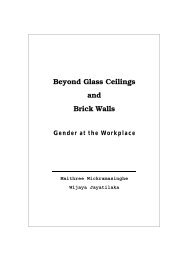SETP No. 14 The Economic Value of Incremental Employment in the ...
SETP No. 14 The Economic Value of Incremental Employment in the ...
SETP No. 14 The Economic Value of Incremental Employment in the ...
You also want an ePaper? Increase the reach of your titles
YUMPU automatically turns print PDFs into web optimized ePapers that Google loves.
3.45 An attempt was made to verify <strong>the</strong> results <strong>in</strong> Table 3.13 and a straw poll was<br />
conducted among builders <strong>in</strong> <strong>the</strong> Western Cape. (<strong>The</strong> poll <strong>in</strong>cluded two<br />
architects, one quantity surveyor, a consult<strong>in</strong>g eng<strong>in</strong>eer and eight build<strong>in</strong>g<br />
contractors). <strong>The</strong> general op<strong>in</strong>ion was that for craft workers <strong>the</strong> adjusted average<br />
salary is close to <strong>the</strong> norm while full time construction labourers will earn closer to<br />
<strong>the</strong> unadjusted monthly salary than to <strong>the</strong> adjusted salary. (<strong>The</strong> adjustment<br />
methodology can bias labourer wages downward by <strong>in</strong>clud<strong>in</strong>g underemployed<br />
labourers and underemployed craft workers with fully employed labourers). As, <strong>of</strong><br />
all <strong>the</strong> prov<strong>in</strong>ces, <strong>the</strong> difference between adjusted and unadjusted labourer<br />
salaries is smallest <strong>in</strong> <strong>the</strong> Western Cape (R55 a day compared to R65 a day), a<br />
challenge rema<strong>in</strong>s for a micro verification <strong>of</strong> <strong>the</strong> accuracy <strong>of</strong> <strong>the</strong>se estimates <strong>in</strong><br />
o<strong>the</strong>r prov<strong>in</strong>ces.<br />
Town and City estimates<br />
3.46 Estimates <strong>of</strong> average salaries paid to craft workers and construction labourers for<br />
a selection <strong>of</strong> towns and cities is presented <strong>in</strong> Table 3.13. <strong>The</strong> table also provides<br />
adjusted average salaries us<strong>in</strong>g <strong>the</strong> same correction procedure used for <strong>the</strong><br />
national and prov<strong>in</strong>cial estimates. As with <strong>the</strong> prov<strong>in</strong>cial estimates, we focus more<br />
on <strong>the</strong> adjusted salaries for craft workers and <strong>the</strong> unadjusted salary for<br />
construction labourers.<br />
3.47 In some <strong>of</strong> <strong>the</strong> smaller prov<strong>in</strong>ces, <strong>the</strong> Western Cape and Gauteng <strong>in</strong> particular,<br />
we note that <strong>the</strong>re are few differences with craft worker salaries with<strong>in</strong> <strong>the</strong><br />
<strong>in</strong>dividual prov<strong>in</strong>ce. This is probably due to <strong>the</strong> mega-city effect and good<br />
transport systems lead<strong>in</strong>g to an equalisation <strong>of</strong> wages. <strong>The</strong> two notable<br />
exceptions are for Soweto <strong>in</strong> Gauteng and Thaba ‘Nchu <strong>in</strong> <strong>the</strong> Free State. Here<br />
wages for craft workers are considerably lower than those <strong>in</strong> <strong>the</strong> nearby cities <strong>of</strong><br />
Johannesburg and Bloemfonte<strong>in</strong> respectively. Because <strong>the</strong> census measures<br />
people’s place <strong>of</strong> residence and not <strong>the</strong>ir place <strong>of</strong> work we do not believe that<br />
<strong>the</strong>re can be such substantial wage differences for <strong>the</strong> same k<strong>in</strong>d <strong>of</strong> labour with<strong>in</strong><br />
what is largely <strong>the</strong> same market. We take it that <strong>the</strong> lower reported wage rates ae<br />
not distortions <strong>in</strong> <strong>the</strong> labour market but <strong>the</strong> result <strong>of</strong> underemployment and<br />
oversupply <strong>of</strong> labourers <strong>in</strong> particular areas, which forces <strong>the</strong> wage rate down.<br />
3.48 In <strong>the</strong> prov<strong>in</strong>ces that are geographically larger we do note more variation <strong>in</strong> <strong>the</strong><br />
average salaries <strong>of</strong> craft workers. We make a general observation (with<br />
exceptions) that <strong>the</strong>re is some correlation between <strong>the</strong> salaries that craft workers<br />
earn <strong>in</strong> construction and <strong>the</strong> size <strong>of</strong> <strong>the</strong> town or city <strong>in</strong> which <strong>the</strong>y work.<br />
3.49 For construction labourers it is not possible to make such generalisations. We<br />
note substantial variation <strong>in</strong> <strong>the</strong> average salaries earned by construction workers<br />
<strong>in</strong> <strong>the</strong> various towns and cities <strong>of</strong> South Africa.<br />
22
















